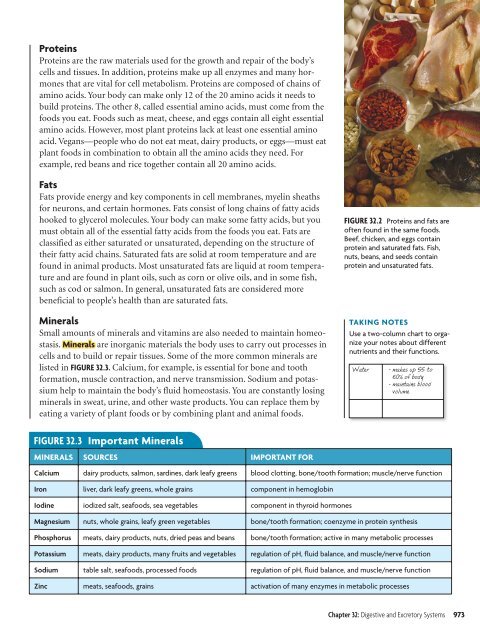Create successful ePaper yourself
Turn your PDF publications into a flip-book with our unique Google optimized e-Paper software.
Proteins<br />
Proteins are the raw materials used for the growth and repair of the body’s<br />
cells and tissues. In addition, proteins make up all enzymes and many hormones<br />
that are vital for cell metabolism. Proteins are composed of chains of<br />
amino acids. Your body can make only 12 of the 20 amino acids it needs to<br />
build proteins. The other 8, called essential amino acids, must come from the<br />
foods you eat. Foods such as meat, cheese, and eggs contain all eight essential<br />
amino acids. However, most plant proteins lack at least one essential amino<br />
acid. Vegans—people who do not eat meat, dairy products, or eggs—must eat<br />
plant foods in combination to obtain all the amino acids they need. For<br />
example, red beans and rice together contain all 20 amino acids.<br />
Fats<br />
Fats provide energy and key components in cell membranes, myelin sheaths<br />
for neurons, and certain hormones. Fats consist of long chains of fatty acids<br />
hooked to glycerol molecules. Your body can make some fatty acids, but you<br />
must obtain all of the essential fatty acids from the foods you eat. Fats are<br />
classified as either saturated or unsaturated, depending on the structure of<br />
their fatty acid chains. Saturated fats are solid at room temperature and are<br />
found in animal products. Most unsaturated fats are liquid at room temperature<br />
and are found in plant oils, such as corn or olive oils, and in some fish,<br />
such as cod or salmon. In general, unsaturated fats are considered more<br />
beneficial to people’s health than are saturated fats.<br />
Minerals<br />
Small amounts of minerals and vitamins are also needed to maintain homeostasis.<br />
Minerals are inorganic materials the body uses to carry out processes in<br />
cells and to build or repair tissues. Some of the more common minerals are<br />
listed in FIGURE 32.3. Calcium, for example, is essential for bone and tooth<br />
formation, muscle contraction, and nerve transmission. Sodium and potassium<br />
help to maintain the body’s fluid homeostasis. You are constantly losing<br />
minerals in sweat, urine, and other waste products. You can replace them by<br />
eating a variety of plant foods or by combining plant and animal foods.<br />
FIGURE 32.2 Proteins and fats are<br />
often found in the same foods.<br />
Beef, chicken, and eggs contain<br />
protein and saturated fats. Fish,<br />
nuts, beans, and seeds contain<br />
protein and unsaturated fats.<br />
TAKING NOTES<br />
Use a two-column chart to organize<br />
your notes about different<br />
nutrients and their functions.<br />
Water<br />
∑- makes up 55 to<br />
60% of body<br />
∑- maintains blood<br />
volume<br />
FIGURE 32.3 Important Minerals<br />
MINERALS SOURCES IMPORTANT FOR<br />
Calcium dairy products, salmon, sardines, dark leafy greens blood clotting, bone/tooth formation; muscle/nerve function<br />
Iron liver, dark leafy greens, whole grains component in hemoglobin<br />
Iodine iodized salt, seafoods, sea vegetables component in thyroid hormones<br />
Magnesium nuts, whole grains, leafy green vegetables bone/tooth formation; coenzyme in protein synthesis<br />
Phosphorus meats, dairy products, nuts, dried peas and beans bone/tooth formation; active in many metabolic processes<br />
Potassium meats, dairy products, many fruits and vegetables regulation of pH, fluid balance, and muscle/nerve function<br />
Sodium table salt, seafoods, processed foods regulation of pH, fluid balance, and muscle/nerve function<br />
Zinc meats, seafoods, grains activation of many enzymes in metabolic processes<br />
Chapter 32: Digestive and <strong>Excretory</strong> <strong>System</strong>s 973

















